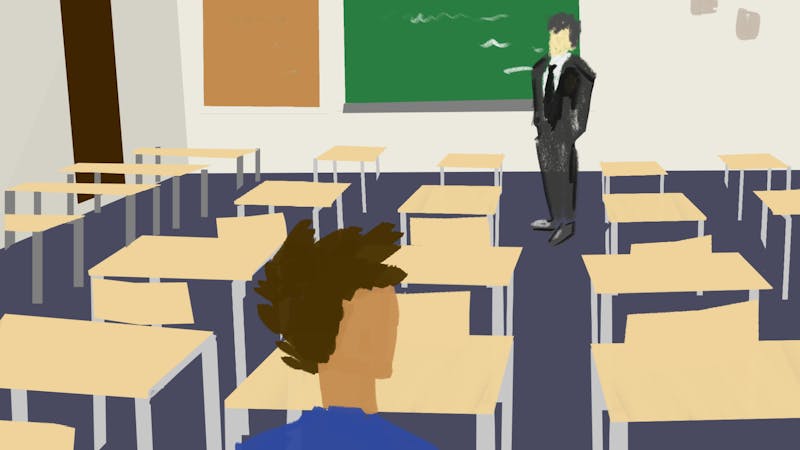Class size growth prompts concerns
The size of Rice University’s student body has increased by 36 percent over the last 12 years as called for by President David Leebron’s Vision for the Second Century; however, the growth has prompted some students and faculty to express concerns about class sizes. According to Leebron and Dean of Undergraduates John Hutchinson, the administration has addressed this by hiring more faculty and looking further into optimal class sizes.
Student body changes
“The goal of the university [was] to increase to a target [of] around 3,800 students,” Hutchinson said. “It was a planned growth ... [We’ve] plateaued now. This year’s enrollment is smaller than last year’s enrollment.”
Hutchinson said there has been a rapid change in the range of studies students are interested in, which has led to a sudden increase in demand for certain classes. The university has responded to this change but not fast enough, Hutchinson said.
“Because we have tenured faculty, it takes a while to be able to adjust to the shifts in [student] demands,” Hutchinson said. “We have recognized there are some problems in some areas that have caused less than satisfactory experiences. Among the things we have done is to identify the areas that have strategic need to make sure we can reduce class sizes in areas that have gotten very large.”
According to Rice University President David Leebron, the number of engineering students, social science students and pre-med students has increased significantly well beyond the amount of the general expansion of the student body. Leebron said the university has devised both long-term and short-term solutions to accommodate the change in student interest.
“The short term, which we have already begun implementing, is to provide some funds to go out and hire additional instructors immediately in these areas,” Leebron said. “In economics, for example, we’ve also made long-term decisions, which [are] to expand the size of the department and recruit additional people.”
Class sizes
Algorithmic Thinking (COMP 182) is one of the classes that has rapidly increased in size over the past three years. The undergraduate enrollment has increased from 94 in spring 2013 to 144 this semester, according to data from the Rice University Office of the Registrar’s website.
COMP 182 professor Luay Nakhleh said the increase in the size of the class has had a negative influence on the teaching experience because there is not enough interaction between the instructor and the students in a bigger class.
“[Smaller classes are] not about [being] easier [to teach],” Nakhleh said. “It's about the learning experience for the students. How much attention we can give to the students and the quality of material we can deliver to the students is necessarily decreasing. I looked at, for example, last year's course evaluations. Students were saying that the size of the class is a problem.”
According to Nakhleh, the instructors share the burden of increasing class sizes by having to provide more sections of the same course. COMP 182 has two additional problem-solving sections this semester.
“This semester, for example, I am teaching, instead of twice, four times a week,” Nakhleh said. “This comes at the expense of me doing research and meeting with my research group. This shows the impact of larger class sizes beyond teaching.”
According to Leebron, a larger class size may not necessarily be less effective than a smaller class size, depending on the structure of the course and the faculty.
“With today’s technology … you might want to use a flipped classroom, [or you] might want to have smaller sections,” Leebron said. “It isn’t every class you want to reduce to 50 ... If you put more people teaching basic chemistry classes, that takes those people away from running advanced chemistry classes that might be smaller. So it’s a question of how you allocate the faculty to achieve the best possible overall educational experience for the students.”
Nakhleh said he believes there are not enough faculty members in the computer science department.
“Except for [California Institute of Technology], we are the smallest in the top 20 [computer science departments in the nation],” Nakhleh said. “We have 18 faculty members. This is a core issue here. We are extremely happy that students are interested in computer science. We are extremely happy to be teaching courses, but we need help. We need to hire more tenure-track faculty members.”
Teaching methods
Baker College sophomore Anna Ng took Comparative Political Behavior (POLI 358) with Amalia Mena-Mora, a professor from the University of Houston, in fall 2014. Ng said Mena-Mora benefited from having a class size of only two students.
“She was really analytical in reading the course material and asked us tons of questions regarding the details and logic of the articles that we read,” Ng said. “We felt really comfortable [asking] questions and [making] comments, and I think that’s especially good for international students majoring in humanities and social sciences.”
Hutchinson said one of the ways Rice maintains an interactive learning experience in large classes is through the Student Centered Active Learning At Rice teaching technique. General Chemistry 1 (CHEM 121) employs the SCALAR method.
“We put students in small groups and had the instructor lead the discussion and challenge the students to work together, while also hiring TAs to circulate through the class,” Hutchinson said. “Would [SCALAR provide an] experience that felt like a smaller class experience and give the student the active learning that you might have in a smaller class? All the preliminary data tell us that the answer to that question is yes.”
Faculty trends
As the student body increased, the number of faculty also increased to maintain the student-faculty ratio, Hutchinson said. However, the undergraduate student-faculty ratio has gone up from 5.7 in academic year 2011 to 6.2 in academic year 2014, according to the Office of Institutional Research website.
“It is the case that the [faculty has] actually grown,” Hutchinson said. “The data shows that the student-faculty ratio has gone up about 10 percent. The student-faculty ratio isn’t the issue. Where people feel the increase in enrollment is in class sizes.”
Data from the Office of Institutional Research shows the number of tenured and tenure-track faculty has grown from 477 to 522, a 9.4 percent increase, since 2004, while the number of non-tenure-track and research faculty has increased by five times from 61 to 320.
Hutchinson said hiring non-tenure-track faculty is a way for the university to respond to changes in student demand.
“If every member of the faculty is tenured in their particular field and there is a sudden shift of student interest on campus, we wouldn’t be able to respond to it,” Hutchinson said. “[Non-tenured professors] also give us the ability to hire faculty whose focus is really on teaching and who want to be outstanding teachers.”
Jenna Netland, an undergraduate teaching assistant for Computational Thinking (COMP 140) in fall 2014 and fall 2013, said it is difficult to find suitable classrooms for larger classes. COMP 140 uses the flipped classroom teaching technique, in which the students watch videos online prior to class and complete practice work in class.
“I think Rice has been running out of the rooms that have the correct size,” Netland, a Martel College junior, said. “Especially for teachers trying the flipped classroom, there are very limited resources available.”
Growing pains
The university has been using some college commons as classrooms for SCALAR classes. Introduction to Sociology (SOCI 101), which has an enrollment of 150 students, is taught in the Lovett College commons.
According to Hutchinson, the use of the Lovett College commons is a mutual agreement between the leadership of Lovett College and the university. Under the agreement, the university can plan classes in the commons only at certain times. The university spent over $200,000 dollars to outfit Lovett commons with a projector, a screen system and a computer system.
McMurtry College sophomore Sejeong Park, who is taking SOCI 101 this semester, said having classes in a college commons can be very distracting.
“Sometimes people [go] downstairs to get food late and our class is at 10 [a.m.], so some people eat [at the commons],” Park said. “Also, some of the people who work at the servery were eating at the area right next to the commons so my professor [had] to talk to them and quiet them down.”
Baker College sophomore Kat Sofjan, who is also taking SOCI 101, said the casual feeling of a college commons makes it a bit harder for students to get into a learning mode.
“In the Lovett commons especially it’s sometimes hard to find a seat where you can actually see what the teacher is presenting,” Sofjan said. “One plus is that it allows Dr. Werth to walk around and interact with us, which adds a lot to the class.”
More from The Rice Thresher

Jones wins men’s and women’s Beer Bike races, GSA snags alumni
Jones College won both the women’s and men’s Beer Bike 2024 races, while the Graduate Student Association claimed the alumni team win. Hanszen College bike teams were the runner-up in the alumni and men’s races, while Brown College was the runner-up in the women’s race. Martel and McMurtry Colleges did not bike in the alumni race, according to the Rice Program Council’s final report, and the GSA was disqualified from the men’s race for accidentally sending out two bikers simultaneously.

Rice wraps up Conversations on the Middle East series, looks to fall semester
With the final session rescheduled to Wednesday April 17, the Conversations on the Middle East series is coming to a close.

Rice SJP hosts protest in response to S.RES 02 tabling
Rice Students for Justice in Palestine staged a walkout and protest in response to the tabling of S.RES 02, a resolution that proposed a divestment of student funds to Israel-aligned companies, outside the Allen Center, April 12. The protest occurred during Owl Days, when prospective students were touring the campus.

Please note All comments are eligible for publication by The Rice Thresher.